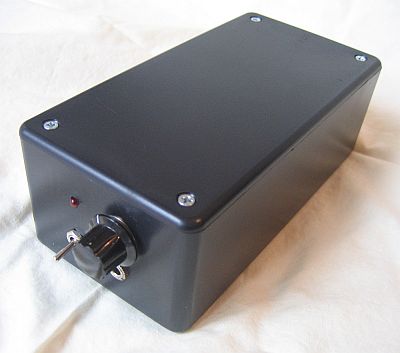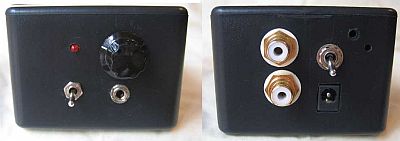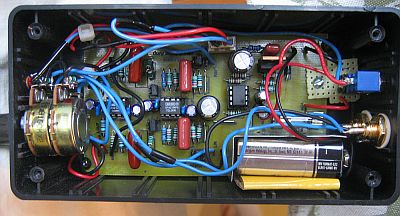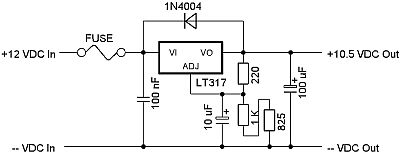| |
 |
| | | |
| |
Introduction |
|
| | | |
| |
The portable headphone amplifier is a solid state device based on the famous CMoy design as described on the old Headwize website. I wanted to use it with my office computer and my Sennheiser HD497 headphones to improve the sound quality of the MP3's I listen to at work. My goal for the project was to make it as cheaply as possible using as many leftover parts as I could. I ended up paying only about $12 at Radio Shack for the case, headphone jack, and two mini toggle switches. Everything else came from my spare parts collection. |
|
| | | |
| |
 |
| | | |
| |
I call this a "portable" amplifier, but I wasn't really going for the Altoids-box-size that many do for the CMoy amplifier because I have no intention of carrying it around. I don't like to listen to music when I am walking, skiing, etc - I perfer to be alert to my surroundings. But, I still wanted it relatively small, so I put the amplifier in a 6" x 3" x 2" Radio Shack project box. The front of the amplifier (left side of the above photo) has an on/off switch, a small red LED indicator light, a volume pot, and a 1/8" headphone jack. |
|
| | | |
| |
Originally, I did not include a volume control, and the unit relied on the source to control the volume. I then decided to buy a decent Alps Blue pot for the main HiFi headphone amplifier, so I suddenly had a surplus Alpha 100 Kohm dual-gange cheapo volume pot as surplus, so I stuck it in this amplifier and wired it directly between the RCA jacks and the amplifier-in connections, along with 15 Kohm resistors from the wipers to ground to create a fake-linear taper. |
|
| | | |
| |
On the back (right side of the above photo) are two gold-plated RCA input jacks, a switch to toggle between the internal 9V battery and the external AC power pack, and the AC power pack connector. I took a standard, shielded patch cable with RCA plugs at one end, and attached a 1/8" miniplug at the other end to connect the amplifier to a sound card or portable CD player. |
|
| | | |
| |
 |
| | | |
| |
Inside the case, the photo above shows the amplifier and power supply on a single large circuit board, the 9V battery, and the internal wiring for all of the switches, LED, volume control, input and output jacks. |
|
| | | |
| |
Power Supply |
|
| | | |
| |
The thinner part of the circuit board next to the battery contains the power supply. The first part of the power supply is a smoothing and regulating circuit for the external 12 VDC power pack only. An adjustable voltage regulator is used to produce a steady 10.5 VDC. The schematic is shown below. |
|
| | | |
| |
 |
| | | |
| |
The output from the regulating circuit goes to the toggle switch, as does the (+) lead from the battery, so that either the battery or the power pack can be selected. That way, there is no drain on the battery when the power pack is used. The output from the switch goes back to the board where it is split from a single supply to a dual supply with a virtual ground using a simple opamp buffer as described here. This technique is much more stable than a simple resister-divider network. The schematic is shown below. |
|
| | | |
| |
 |
| | | |
| |
The rail-splitter circuit described above produces +/- 5.25 VDC when the external power pack is used, or +/- 4.5 VDC when the 9 V battery is used. |
|
| | | |
| |
Headphone Amplifier Circuit |
|
| | | |
| |
The amplifier incorporates an input gain stage (10X), a bass-enhanced natural crossfeed circuit, and a buffered, unity-gain output stage. Both stages use OPA2134 opamps. The shematic for one channel is shown below. |
|
| | | |
| |
 |
| | | |
| |
Between the two opamps is a bass-enhanced, natural crossfeed circuit, as described on the other headphone amplifier page. Here there is only one setting (approximately equivalent to the High setting on the other amplifier), and there is a jumper that can be used to enable or bypass the crossfeed circuit. |
|
| | | |
| |
Three parallel resistors in series with the imput allow you to roughly set the signal volume so it is in sync with the source. The resistors are 100 Kohms, 182 Kohms, and 330 Kohms. Nothing magic about the numbers; they are just what I had on hand. |
|
| | | |
| |
Conclusion |
|
| | | |
| |
How does it sound? Very nice. The crossfeed circuit is especially nice. It really improves this whole computer-sound card-MP3 business a lot. Highly recommended. |
|
| | | |
| |
Note: The box for this little amplifier was repurposed in 2016 and used to contain the new JLH discrete portable headphone amplifier, as described here. |
|
| | | |
| |
Back |
|





